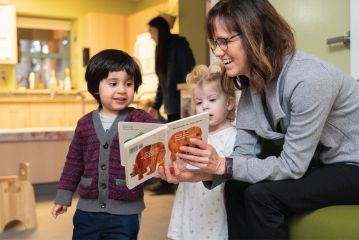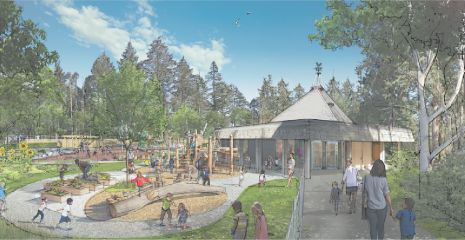The child care capacity challenge
- Robie Liscomb
For the past several years, UVic students, faculty and staff have faced increasing difficulty finding suitable child care spaces on or off campus. “The quality of care provided by UVic Child Care Services is stellar,” says Grace Wong Sneddon, interim associate director of Student and Ancillary Services. But the demand for spaces in UVic’s child care centres greatly exceeds the supply.
However, a constellation of recent initiatives and developments at UVic is presenting a valuable opportunity to address the problem.
“The university understands the need for increased access to quality child care,” says UVic Vice-President Finance and Operations Gayle Gorrill. “We have a shared interest in this with faculty, student and staff parents and are making efforts to find long-term, sustainable solutions to address the need for additional high-quality child care options.”
Currently, Child Care Services provides spaces for 88 children: 10 infants (with a waiting list of 47), 28 toddler spaces (with 122 on the wait list), 25 pre-schoolers (with 69 waiting), and 25 kindergarten age children (with 31 waitlisted). There are also 50 spaces in the out-of-school care program (with 19 on the wait list). Wait times for spaces range from several months to two or more years.
“There has always been a waiting list for UVic child care,” explains Dr. Lynne Marks (history), “but in the last two years, things have become worse, in part because of developments beyond UVic.” Marks has long been involved in the child care issue, most recently as chair of the UVic Academic Women’s Caucus and co-chair of the newly established UVic Child Care Action Group. She is also a member of the UVic Child Care Parent Advisory Board.
Child care spaces are very tight off-campus as well, leading to similarly lengthy waiting lists. Marks cites the cancellation of the federal childcare policy and the failure of provincial child care subsidies to keep pace with costs as playing a major role in the reduction of available and affordable child care spaces locally.
UVic’s Jan Nolan, director of faculty renewal and academic leadership initiatives, describes the child care situation in Victoria as an unfortunate “perfect storm.” “In recent years, there has been a combination of factors including low pay for child care workers, few spaces for child care training, and Victoria’s relative lack of a new Canadian population that, in other cities, has provided in-home child care as a means of generating income.”
According to the Victoria Foundation, there were only 5,161 registered child care spaces in the Capitol Region, to serve a population of 17,325 children under six years of age.
Both Nolan and Marks point out that this situation will likely get worse, as three major child care centres in Victoria announced in March that they are closing, meaning the loss of an additional 100 spaces in the city.
Last year, Vice-President Academic and Provost Jamie Cassels asked Nolan and Wong Sneddon to explore maximizing the use of current resources on campus and to develop collaborations with others to help address the child care need.
Wong Sneddon has worked with Child Care Services to create 16 part-time pre-school-age spaces in Centre 6, which in the afternoons houses the out-of-school program. These spaces will be available, beginning in September, from 8 a.m. to 12:30 p.m. on weekdays, but not during public school holidays or professional development days, when it is needed for the out-of-school-care program.
Meanwhile, Nolan has been working closely with the UVic Family Centre on a program to provide training for Family Housing residents who wish to offer in-home child care. This has involved providing an information session for those interested, an infant/child first aid and CPR course, and a field trip to the Victoria Child Care Resource and Referral agency, which trains and registers such caregivers. Further development of this approach awaits implementation of the recommendations of the external review of the UVic Family Centre, which was completed recently.
The university has also created a child care steering committee, charged with investigating the full range of models of child care service delivery, evaluating the suitability of various options in the local context, and identifying the associated capital and operating costs and the rate implications for families. Sponsored by Cassels and Gorrill, the committee includes Associate Vice-President Student Affairs Jim Dunsdon, Associate Vice-President Financial Planning Kristi Simpson, as well as Nolan and Wong Sneddon.
“We want to proceed in a responsible and thorough manner in addressing this important need,” explains Gorrill. “We need to clearly understand the short-term and long-term needs, opportunities and challenges. We need to do this right so that we have a sustainable solution.” Their report is expected to go to the board of governors in late September.
Universities across Canada and the United States are facing a similar child care capacity challenge, and they are pursuing a variety of models. These include building new child care centres or expanding existing ones, partnering with other large employers or third-party providers, and supporting networks of in-home services.
Here in BC, Gorrill points out, both UBC and SFU have been required to provide, and have accordingly benefited from, child care spaces provided in association with campus real estate development—an option that UVic, due to its much smaller land base, does not have. UBC has recently opened five new child care centres, administered by housing services and with a funding stream supported by real estate development.
UVic Child Care Services receives funding from parent fees, a provincial government child care operating grant and UVic transfer funds. The university covers salary and benefits costs for the manager and clerical support staff, and currently provides $355,000 per year in additional subsidies. This is different from other ancillary services, such as Housing, Food and Conference Services, that are expected to recover all of their operating and capital costs from fees for services or sale of goods.
Child Care Services is undergoing a regular external review over the summer, and among issues it will explore are increasing capacity within the current physical structure, maintaining the high quality of care currently provided and increasing collaboration with academic units, such as the School of Child and Youth Care and the Faculty of Education.
In preparation for the external review, a comprehensive self-study of Child Care Services was recently completed by a small team which included Child Care Services Manager Jack Lalonde, Dr. Veronica Pacini-Ketchabaw (child and youth care) and Wong-Sneddon in consultation with others.
Meanwhile, people from across campus with a particular interest in the issue have joined together to launch the UVic Child Care Action Group and strategize about ways to increase the number of child care spaces at UVic. “We include faculty members, representatives from CUPE locals 951 and 4163 and the PEA, the Graduate Students Society and the Office of Indigenous Affairs,” says Marks, who is co-chair of the group along with Dr. Stephen Ross (English) and Michael Lines (law library).



